by Dr. Anand Titus and Geeta N. Pereira
Shade grown coffee plantations are one of India’s best kept secrets. These coffee farms are located in tropical belts, where the sun shines strongly, warming the coffee mountain. As such, the coffee farms receive abundant sunlight. The photosynthetic machinery of the three tiered tree canopy makes maximum use of solar radiation with the help of chlorophyll in synthesizing carbohydrates and sugars.

Due to the interplay of various biotic partners inside the coffee forest the biomass production at any given time is relatively high. It is an established fact that organic wastes are building up rapidly in every acre of coffee because of the multi diversity of trees, herbs and shrubs.
However, coffee farmers are not in a position to harvest the locked up energy in these substrates. It is not clear just how much of these wastes are now converted into organic fertilizers, or are likely to be converted in the future. Coffee farmers need to be aware that the limitation to the increased productivity of coffee is not the soil nutrients, but the rate of recycling of biomass within the confines of the coffee mountain.
The strength of this article is based on three core ideas.
- Field application of neem in different forms acts as a precursor for the stimulation of beneficial micro flora, there by releasing the locked up energy in the accumulated biomass, converting them into energy rich compounds. The key idea rests in the fact that this energy is not only useful for the growth, development and productivity of coffee but serves as a common denominator in nourishing the biotic components of the entire coffee mountain.
- Neem and its derivatives act as PROPHYLATIC [Preventive treatment] agents in the control of pest and disease incidence.
- The addition of neem conserves parasites and predators of insect pests. Infact, the neem environment shapes the predator prey relationship inside the coffee mountain.
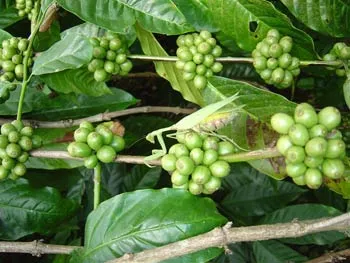
Neem (Azadirachta indica) also known as Melia azadirachta belongs to the family, Meliaceae and is a native of the Indian subcontinent. The agricultural and medicinal importance of this multi purpose tree was known to Indians since centuries. The use of neem in coffee Plantations is not something new.
For ages, Coffee farmers have taken advantage of Neem as a soil amendment and insect repellant without understanding its true nature. It is only off late with the latest advancement in science and technology that the various components of neem and its active ingredients have been isolated , thereby enabling the coffee farmers in appreciating the role of neem in regulating the living processes inside the coffee habitat. Today, scientists are of the opinion that every part of the tree has a well defined use.
The coffee farmer has two advantages with respect to neem, namely availability of large quantities at a reasonable cost and secondly, since neem is available in areas surrounding plantation districts, the transportation cost is minimized.
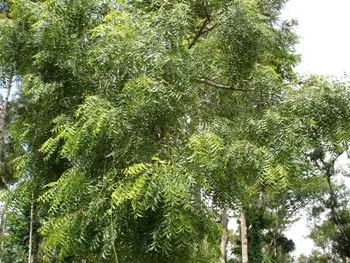
FUTURE TRENDS OF NEEM & ITS BY-PRODUCTS
- Regulates nitrogen release from nitrogenous fertilizers.
- Bio activity against plant pathogens and pests.
- Soil conditioner
- Lowers the C: N ratio of soil organic matter.
- Enhances the spread and multiplication of beneficial micro flora.
- Soil conservation
- Excellent source of organic nitrogen.
- Exerts behavioral, Physiological and biochemical effects on insects.
- Excellent soil amendment.
- Non development of resistance of microorganisms towards neem based products.
- Harmless nature; against non target organisms.
- Lack of any residue problem.
- Acts as an excellent input in the use of Integrated Pest Management.
- Excellent air purifier as well as wind breaks.
- Increases soil fertility and soil water holding capacity.
- Neem can balance acidic soils of calcium mines and neutralize them.
- Wood is excellent in manufacturing agricultural implements.
- Useful tree in rehabilitating waste land areas.
- Very effective against global warming.
- Toxicants produced during microbial degradation of neem inhibit several stages of pest population.
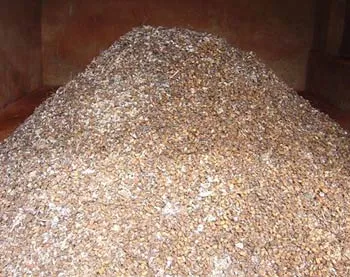
POLICY MATTER
Right from patents, commercialization of neem has flooded the market with thousands of formulations and an even greater number of products. A detailed data base of the various products and the concentration of active ingredients need to be established before field application of neem is carried out.
The various parts of the neem tree, including the seed are bitter and some parts have a sharp pungent taste. The tree as such is a treasure house of different biologically active compounds which are chemically diverse and structurally stable and complex. The active ingredient Azadirachtin is active against a whole range of harmful insect populations.
Coffee farmers are under a spell to grow exotic trees like mangium, mesopsis, etc, which mine the precious nutrients from the coffee mountain. Instead, they could grow neem in either paddy fields adjoining the coffee belts or grow it along the bio-fence. Neem is known to have a wide adaptation and tolerance to varied soil and climatic conditions. It does not demand rich soils for its growth and development. It grows successfully on dry stoney, clayey soils and can thrive well in leached sandy soils.
CONSTITUENTS OF NEEM FRUIT
Neem fruit is a berry which is green when unripe. As ripening progresses the color of the outer skin; pericarp changes from green to yellow. On maturity the fruit is very fleshy and fresh fruit has 40 to 50 % moisture. 40 kilograms of fresh fruit yields 24 kilograms of dry fruit, yielding in turn 11.52 kg pulp, 1.10 kg seed coat, 4.0 kg husk and 5.48 kg kernels. The kernels are the richest source of oil as well as oleo chemicals. Oil and cake constitute nearly 45 and 55 % respectively of neem seed kernels.
ACTION OF NEEM AGAINST PEST & DISEASE INCIDENCE
Research data suggests that more than 300 species of insects can be controlled with the help of neem products. In addition neem has promising nematicidal and fungi toxic activity. In India, neem has been evaluated against 125 species of pests of agricultural importance. All parts of the tree are known to be biologically active. The maximum insecticidal activity is in seed kernel. Scientific review of papers shows that neem also possesses insect growth regulatory effect.
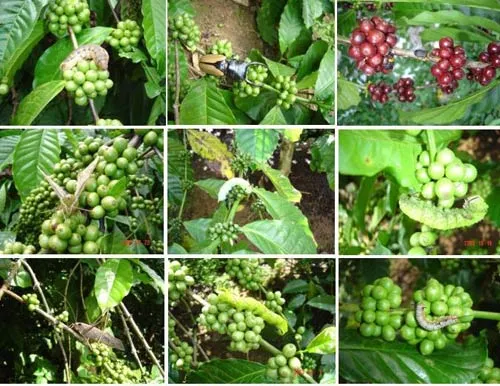
Insect Control with Application of Neem
AGRICULTURAL FORMULATIONS
Neem is known to contain over 100 biologically active constituents that can be used in various agricultural formulations like Insecticides, Fungicides, Bactericides, Nematicides, and Antiviral compounds.
According to B. N. Vyas and K.B. Mistry, there is considerable emphasis placed on the development of neem pesticides based on AZADIRACHTIN, which is the most widely evaluated neem compound. However, they are of the opinion that, it may not be advisable to develop a product based on pure azadirachtin alone because of the following reasons.
- At least 50 neem compounds are reported in literature to possess antifeedant / repellent and / or insect growth regulating activities.
- There is always a danger of development of resistance in insects against a product containing a single active molecule.
- There is hardly any evidence of the antagonistic effects of one neem compound on the other. Literature survey reveals that under many situations , crude or semi purified extracts of seeds give similar results as compared to pure azadirachtin and in fact, in many situations , crude extracts perform better than azadirachtin alone based preparations.
- Greater technical skills are required to produce very high concentrations of azadirachtin in technical grade material which also leads to market escalation cost.
JOE’S SUSTAINABLE FARM: KIREHULLY ESTATE
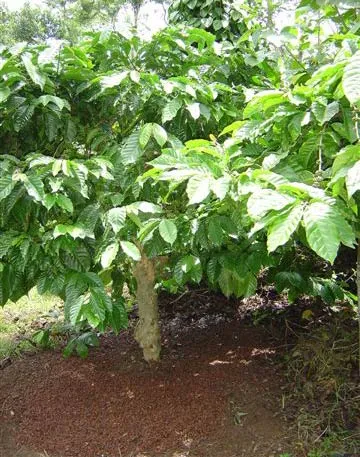
It has been an age old tradition to use various neem products on this farm for the past four decades. Neem has been a central organic amendment in our farm. Oiled as well as deoiled neem cake has been mixed with compost and synthetic urea and the same applied to the farm.
However for the past three years we have been procuring fresh neem seeds directly from the farmers and broadcasting the same to the field. The idea behind this change is to stabilize the carbon: nitrogen ratio such that the microbial activity increases and provides for better utilization of organic wastes. The application of neem stimulates soil micro flora. The dense mulch and organic matter on the floor bed of the plantation together with neem increases heterotrophic microbial activity and organic matter decomposition.
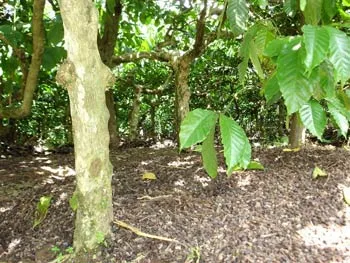
VARIOUS NEEM COMBINATIONS
- FRESH NEEM SEEDS directly broadcasted to the coffee farm
- Drying neem seeds for a period of 15 days and then broadcasting.
- Coarse Powdering of neem seeds with the help of a roller and then broad casting the same.
- Partial Composting of neem seeds with sheep, and poultry litter separately and together for a period of three months (above ground method) together with parchment husk and broadcasting the same to the farm.
- Composting neem seeds with other organic manures by the PIT method (Refer Fine art of composting) for a period of one year and then broadcasting the same.
- Applying commercially available neem cake ( oiled and deoiled )
- Mixing neem seeds with urea, rock phosphate and potash and broad casting the same in the month of September.

[P.N. Points 1 to 7: After broadcasting neem, scuffle digging or deep digging was undertaken, to accelerate the rate of organic matter decomposition]
LOW COST TECHNOLOGY FOR RAPID MULTIPLICATION OF INDIGENOUS MICROFLORA
In order to multiply the native micro flora, the following experiment was carried out. For every barrel {180 liters} of water, 10 kilograms of fresh cattle dung was added and the same was allowed to ferment for just one week with constant rotation to facilitate aeration.
Also, fresh soil from fertile (trenches) blocks was kept in a shaded place under moist conditions. At weekly intervals, the mixture in the barrel was sprinkled over the neem seeds together with a thin layer of moist soil. The entire heap of neem was manually turned upside down and accordingly broad casted to the coffee farm.
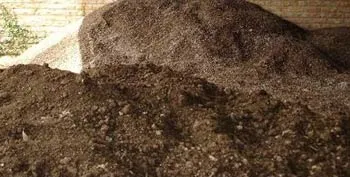
Neem Seeds and Poultry Manure Prior to Mixing
THE FARM AS A COMPOST BIN: CONCEPT OF EXTENDED COMPOST UNIT
A new experiment is unfolding at Joe’s Sustainable farm. Instead of having location specific compost pits we are experimenting in considering the entire farm as a single extended compost unit. To begin with we have considered 25 acres as one working unit. In time this concept will be extended to the entire farm.
Our hypothesis is based on five key ideas.
- Symbiosis among various biotic partners.
- Ready availability of tons of biomass produced periodically due to leaf Shedding from forest trees as well as from coffee bush, herbs & shrubs.

Biomass Accumulation on the Floor of Coffee Forest
- Presence of associative and free-living micro flora responsible for nitrogen Fixation, phosphorus solubilisation and other organic conversions.
- Presence of succulent weeds (three round of weeding operations are carried Out in shade grown Indian coffee farms)
- Shade lopping every two to three years produces woody biomass which is Removed from the farm as fuel. Converting woody material into energy rich Compounds are our area of concern.
MODIFICATION OF SOIL MICROFLORA BY ADDITION OF NEEM
Since Indian Coffee Plantations are greatly influenced by the FOREST FACTOR, there is a tremendous amount of well scattered biomass which needs to be recycled for the periodic release of nutrients. The unfortunate part is the non availability of a large number of beneficial strains of soil microbes to act on this raw material. Our idea is to create a suitable environment for the accelerated growth and multiplication of different strains of indigenous beneficial microbes which are already present on the farm by the application of neem in different forms. Our experiments prove beyond doubt that it is possible under field conditions to stimulate the micro flora composition by adding neem.

Neem Seeds Composted With Sheep and Poultry Manure
Our past experience has pointed out very clearly that the micro flora within the coffee mountain is in equilibrium with the environment and that introduced microorganisms must compete with indigenous micro flora. Hence, our idea of providing a niche for the native soil flora by the addition of neem, was to enable them to multiply without stress.
NEEM AND THE VALUE OF WEEDS
A healthy soil consists of diverse species of weeds, both monocots and dicots. Indian coffee farms mimic nature and as a result during the monsoon, the farms are covered with an amazingly diverse species of weeds. Our objective is to help coffee farmers realize the value of weeds as an excellent base for the build up of both beneficial microbes and native flora. We manually trim the weeds by the slash method and then broadcast the same, followed by neem application.
Our observations point out that this practice increases the macro and micro flora resulting in the availability of mineral nutrients to the soil in a gradual and continuous manner. The most important observation is that the weeds and neem combine together in a symbiotic relationship, changing the soil, leading to the natural progression of different kinds of weeds that are succulent in nature.
POSITIVE TRENDS OBSERVED DUE TO REPEATED NEEM APPLICATION
- Improves health and vigor of the plant.
- Improves soil fertility, soil texture and porosity.
- Improves soil aeration, resulting in well established net work of roots.
- Improves the nutrient retaining properties of the soil.
- Availability of nutrients in the soluble form coinciding with the growth and development stages of the plant.
- Soil micro flora is enriched.
- Improved Drought tolerance by build up of stable humus, improvement of soil structure and water.
- The leaf appears dark green and promotes increased photosynthetic activity.
- Leaf has a thick cuticle which acts as a barrier in preventing insect and microbial attack.
- The plantation is by and large resistant to attack by insects and microbial pathogens.
- The size of the coffee beans is uniform and also bigger in size compared to blocks without neem application.
- During monsoons season, if there is no break in rain spells then application of neem controls berry drop.
- During long periods of drought, the soil treated with neem acts as a defense mechanism to protect the overall integrity of the farm.
- Increases the percentage of uniform ripening of beans.
- Increases the percentage of flower setting.
- Increases the dry matter content of coffee.
- Increases honey bee population during flowering.
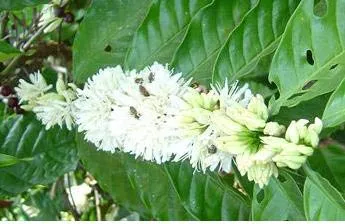
Increased Honeybee Population – Neem
RECOMMENDATIONS FOR RESEARCH
Application of various forms of neem has been a regular practice at Joe’s Sustainable farm for many decades. Our remaining task is two fold. To evaluate the past work and to indicate what the future requires. In the search for methods to enhance neem application, only practices and schemes that have a chance of adoption by a large number of coffee farmers should be seriously considered. Most importantly, the practice of applying neem should fit into the coffee farmer’s package of practice.
CONCLUSION
In the 21st century the world is considered a global village. However, as the world is shrinking, agriculturists in the developing world are fighting many loosing battles because of the onslaught of multinationals. Every seed or the bio components there in are patented and farmers need to pay a hefty price just to buy them. It’s a small world with big battles.
John Vidal reports in the GUARDIAN that Global food companies are aggravating poverty in developing countries by dominating markets, buying up seed firms and forcing down prices for staple goods including tea, coffee, milk, bananas and wheat. Just 30 companies now account for a third of the world’s processed food; five companies control 75% of the international grain trade; and six companies manage 75% of the global pesticide market. Two companies dominate sales of half the world bananas, three trade ; 85 % of the world’s tea, and one, Wal-mart, now controls 40 % of Mexico’s retail food sector.Monsanto controls 91 % of the global GM seed market. In short, the report highlights how power in the world agriculture and food industry has become concentrated in a few hands. John Samuel of Action Aid says that it is a dangerous situation when so few companies control so many lives.
Earlier, the story was different. Nature’s wisdom book was open for all of humanity. Coffee farmers were a satisfied lot. They used to try out traditional methods and by word of mouth communicate the success of their ingenious experiments. There were no secrets to hide. It took years of patient work to understand the coffee habitat and its needs. Infact, the Indian coffee habitat is a living laboratory which provides a great opportunity to study nature’s patterns. With the advent of commercialization, farmers have to pay a hefty price to acquire basic knowledge.
Due to the global dip in coffee prices, the relationship between the coffee farmer and the coffee habitat too is under stress. In the coming years, due to high pest and disease incidence, we won’t be too surprised to see Arabica farms being wiped out from the map of India. Scientists and coffee farmers have no clue as to what needs to be done to resurrect Arabica farms!
World wide, coffee farmers need to think logically towards the balanced exploitation of the coffee mountain resources in accordance with the requirements of the coffee habitat and the biotic partners associated with it. We also need to carefully examine the requirements of the plant environment, internal and external, natural and artificial, short term and long term in achieving a sustainable balance. Technology should aim at strengthening sustainability by building the natural resource base. NEEM and its useful role in coffee farms will definitely help to answer the difficult questions of tomorrow.
REFERENCES
Invisible Communications in Coffee Plantations
Organic Matter Decomposition In Coffee Plantations
The Fine Art of Composting In Coffee Plantations
Global Warming in Coffee Plantations
Biodiversity In Relation To Coffee Plantations
Significance of Microbial Interactions Within Coffee Plantations
Role of Bacteria in Coffee Plantation Ecology
Role of Fungi in Coffee Plantation Ecology
The Role of Actinomycetes in Coffee Plantation Ecology
Role of Ectomycorrhizae In Coffee Plantations
Coffee Plantations A Multidisciplinary Approach
Arora. R. & G.S. Dhaliwal. 1994. Botanical pesticides in insect management ; Ecological perspectives. In: Management of agricultural pollution in India. (Eds. G.S.Dhailiwal 7 B.D.Kansal ). Commonwealth Publishers. New Delhi.
Battu. G.S., Dhaliwal.G.S. and A.K.Raheja. 1994. Biotechnology; Perspectives in insect pest management. In: Trends in agricultural insect pest management. (Eds. G.S. Dhaliwal and Ramesh Arora). Commonwealth Publishers, New Delhi.
Benge. M.D. 1988. In: Focus on photochemical pesticides. Vol-1. The neem tree. (Ed. Martin Jacobson) CRC Press Inc., Boca Raton, Florida.
Chiu, S.F. (1984), Proc. II Int. Neem Conf. FRG.
Coffee Guide. 2000. Central Coffee Research Institute, Coffee Research Station. Chikmagalur District. Karnataka. India.
Claude Alvares. 1999. The Organic Farming Source Book. The Other India Press, Mapusa 403 507 Goa, India.
Hegde. N. G. 1992. Neem: Silviculture and production. Neem Newsletter 9: 1-4.
IARI. 1993. Neem in agriculture. Eds. B.S. Parmar & R.P. Singh. Res.Bull No.40. Indian Agriculture Research Institute. New Delhi.
Jacobson, M. (1986) 3rd Intern. Work, Conf. Stored Prod. Entomol, Kansas.
Jacobson, M. (Ed) 1988. Focus on photochemical pesticides. Volume-1. The neem tree. CRC Press, Inc. Boca Raton, Florida. U.S.A.
Karim, A. (1980) Proc. 1st Inter, Neem Conf. Rottach – Egern., FRG : 223 – 250.
Kraus. W. 1991. Constituents of neem and other Meliaceae Species in pest control. Symp. Resources for Sustainable Agriculture: The use of neem and other plant materials for pest control and rural development. East -West center. Honolulu, Hawaii 96848. U.S.A. Neem Newsletter 8 (3-4): 25.
Lewis, W. H. and Elvin – Lewis, M.P.E. (1983) Eco. Bol. Vol. 37 (1): 69 -70
Locke. J.C. & R.H. Lawson.1990. Neem’s potential in pest management programs. Proceedings of the USDA Neem workshop, Beltsville, Maryland.
Meisner, I; kehi, M; Zur, M. and Eizick (1978) Phytoparositica vol. 6:85-88.
National Research Council. 1992. Neem: A tree for solving global problems. National Academy Press. Washington. D.C. U.S.A.
Randhwa. N.S. and B.S. Parmar. (Eds) 1993. NEEM. Society of Pesticide Science, India. New Age International (P) Limited, Publishers. New Delhi.
Randhwa. N.S. and B.S. Parmar. (Eds) 2000. Neem research and development. SPS Publication No. 3. Society of Pesticide Science, India.
Schmutterer, H. (1984) Mitteil, ungin aus der Sio, sound. Fur and forst Berlin- Dahlem: 233-333.
Tweari. D. N. 1992. Monograph on neem ( Azadirachta indica A.Juss). International Book Distributors, Dehra Dun, India.
Vyas B. N. and K.B. Mistry. 2000. Processing and Standardization. In NEEM Edited by. N.S. Randhwa and B.S. Parmar. Society of Pesticide Science, India. New Age International (P) Limited, Publishers. New Delhi.